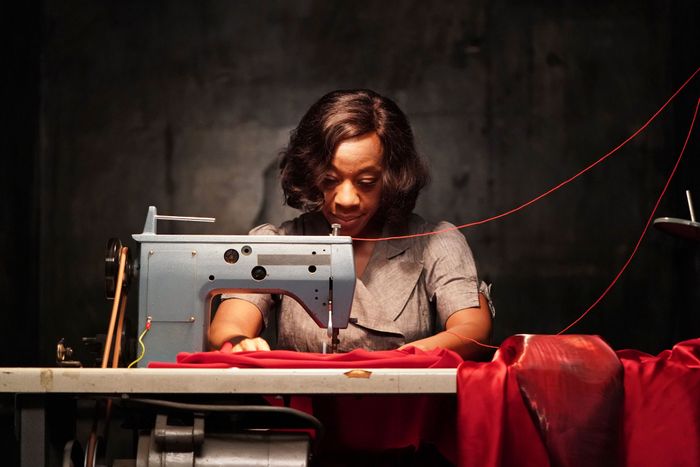
ThereÔÇÖs only one movie from 2019 that featured a murderous gown, a menstruating mannequin, and long monologues about washing machines that function as erotic ASMR. That movie is writer-director Peter StricklandÔÇÖs In Fabric, a darkly comedic horror film about the power of coveting clothes.
Set during the January sales of 1993, the center of Fabrics universe is Dentley & Sopers, a department store dripping in mid-century retail glitz. Though not thematically a giallo picture, Stricklands latest is aesthetically a descendent of those decadent Italian genre films, and much like the filmmakers previous effort, The Duke of Burgundy, a meticulously styled world of beauty and fine things obfuscates an interior world that is  just a bit off. Dentley & Sopers is presided over by a surly, withered man named Mr. Lundy (Richard Bremmer), and the face of the store is Miss Luckmoore (Fatma Mohamed), a mysterious woman with a religious sort of devotion to the act of shopping. Over the course of In Fabric, she enchants her customers into making purchases, pushing one red dress particularly hard onto a lonely single mom (Marianne Jean-Baptiste) looking to feel her best on date night. Behind the scenes, supernatural business is afoot; we soon learn this garment will wreak havoc on whoever comes to own it.
Just before In Fabric hit theaters (itÔÇÖs now available to watch on demand), Vulture spoke with Strickland about his undeniably perplexing film, why he had to cut an ejaculation scene to accommodate the MPAA, and what the hell ÔÇ£chic menstrual tastingÔÇØ means.
What came first when you started writing In Fabric, the dress or the world around it?
Oh, the dress first. Absolutely. I was always thinking of an object that was malevolent. I really wanted to explore responses to clothing, but I wasnÔÇÖt interested in fashion as such. I was more interested in this very visceral response to clothing. How you feel when you put something on, how you can transform yourself, and how you can escape all your problems? You know, the things that drive us to buy something.
WeÔÇÖre also looking at body dysmorphia, how you are a prisoner to your perception of yourself ÔÇö maybe your distorted perception, fetishism, and how itÔÇÖs very difficult to throw a dead personÔÇÖs clothing away. I think clothing is inherently haunted to some degree. Once itÔÇÖs been worn by someone it contains its own power, whether itÔÇÖs the power to disgust you, the power to turn you on, or the power to make you cry. So I guess I wanted to do a genre film, but I wanted to look at this way that characters are ruled by clothing.
YouÔÇÖre really changing my outlook on consignment shopping.
Sorry! [Laughs.] I remember one jacket I bought had this stink of body odor on the armpit, and itÔÇÖs a very weird feeling. ItÔÇÖs kind of like a proxy intimacy, because youÔÇÖll never know what that person looked like, so you just start imagining things. Once the human presence is on clothing youÔÇÖve got a lot of mileage to tell all kinds of stories. There are all these kinds of fantastical elements where bodily fluids could be acting as dye for the clothing, with the menstrual blood and the blood from the veins of the characters.
The Phantom Thread IÔÇÖve been waiting for, honestly.
Oh, I love that movie. You know, I saw Phantom Thread just when we finished shooting, and I kind of wish I saw it before, because there were some things I might have stolen from it [laughs].
I was terrified of mannequins when I was younger, and I really appreciate how this movie captured their truly ominous nature. 
´╗┐I mean, thatÔÇÖs how I saw it as a kid. The way they were positioned, it felt like they were nodding at me, and I remember the hands because back in the ÔÇÖ70s, they were much more angular than they are now, much harsher. The fingers were longer and splayed out as if they were casting a spell on you. I remember my mother used to take me to the shops in a pushchair, and I was parked just underneath one mannequin. Sometimes I think that might explain why I lost my hair. But yeah. TheyÔÇÖre very eerie things, very scary.
You mentioned bodily fluids earlier and I wondered, did you always have a menstruating mannequin sex scene in the script, or did that get teased out along the way of writing?
´╗┐I wrote that quite late actually. What was annoying about that scene was we didnÔÇÖt have time to finish it. A very important element is when Mr. Lundy ejaculates and it lands on a dress, which is for sale the next morning. The semen dries into this silvery pattern that looks like a design that somebody thinks looks good and buys it, which really keyed into the idea of having body fluids acting as design or acting as dyes. ItÔÇÖs just a real shame that we couldnÔÇÖt finish it. The MPAA demanded we cut it, otherwise we were going to get a harsher rating for the film. We were not allowed to show Fatma licking [the menstrual blood from the mannequin]. Of course, I would never judge any individual who finds it hard to watch, but I still think it should be up to a paying audience to decide if they want to walk out or not. We are so used to seeing women being mutilated [onscreen]. Surely, come on, you can put up with a bit of chic menstrual tasting versus serious, horrific mutilation. I mean, itÔÇÖs just not remotely on the same level. But I donÔÇÖt want to get into this kind of moralistic argument.
Right. There are eight Saw movies, and this is one woman licking vagina blood off her fingers. ItÔÇÖs a bizarre double standard.
´╗┐I admit it is a bizarre scene, but still within the realm of being consensual. I would never force it on somebody if they didnÔÇÖt want to watch. I respect that. But it seems bizarre, as you say, to allow horrific murder and torture in other films but not something as innocent as that, really.
Every single line Fatma Mohamed delivers as the lead shop woman is incredible. Purchasing clothes is an act of poetry for her. Tell me how you feel about the retail experience and why you made the most florid dialogue in the film about shopping.
´╗┐It was a mixture of my response to her performance in my previous film, The Duke of Burgundy, where she brought this flamboyance to my dialogue, and I really wanted to go further with it. Plus, I was thinking about having worked in retail and how the British use euphemistic language so cunningly. Right now theyÔÇÖre trying to increase the retirement age to 75 and they have this hashtag, #AgeConfidence. ItÔÇÖs just bizarre, and I remember this job advertised for a night shift stacking shelves in a warehouse. The job title was ÔÇ£twilight replenishment operative.ÔÇØ
Of course IÔÇÖm exaggerating, but IÔÇÖm stretching the elastic of believability. IÔÇÖm never snapping that elastic. So there is this playful, satirical element to it, but also there is this love of a certain type of shop. I remember those stores. I come from a middle-class family, but the type of stores my mother used to go were always middle-class aspirational. There was this element of fantasy. Once you stepped into a changing room, you were imagining yourself being invited to canap├®s at the Swiss embassy, or whatever ÔÇö some element of fantasy. They were always aspiring to elegance, but they were always slightly off.
I read you say that thereÔÇÖs a bit of you reflected by in each character, so in what ways is FatmaÔÇÖs Miss Luckmoore you?
´╗┐Um, woo! Maybe itÔÇÖs best to leave it as a mystery? I think when you write, itÔÇÖs a very weird tension between confession and playing a game of hide-and-seek with the audience. YouÔÇÖre both revealing yourself and hiding yourself. What was interesting is the gender thing. In a way, you can hide more effectively in a different gender. I guess this is no big secret, but IÔÇÖve always loved flamboyance in film, whether itÔÇÖs George Kuchar or itÔÇÖs Anna Biller or itÔÇÖs Visconti, Douglas Sirk. IÔÇÖve always loved that aesthetic, and I think Miss Luckmoore really had that for me, this very sensual approach to things. Also, I always wanted to write a bad character that I could love. IÔÇÖve always loved the Wicked Witch of the West in the Wizard of Oz, so thereÔÇÖs definitely an element of putting a lot of love into FatmaÔÇÖs character even though she is pretty dastardly.



